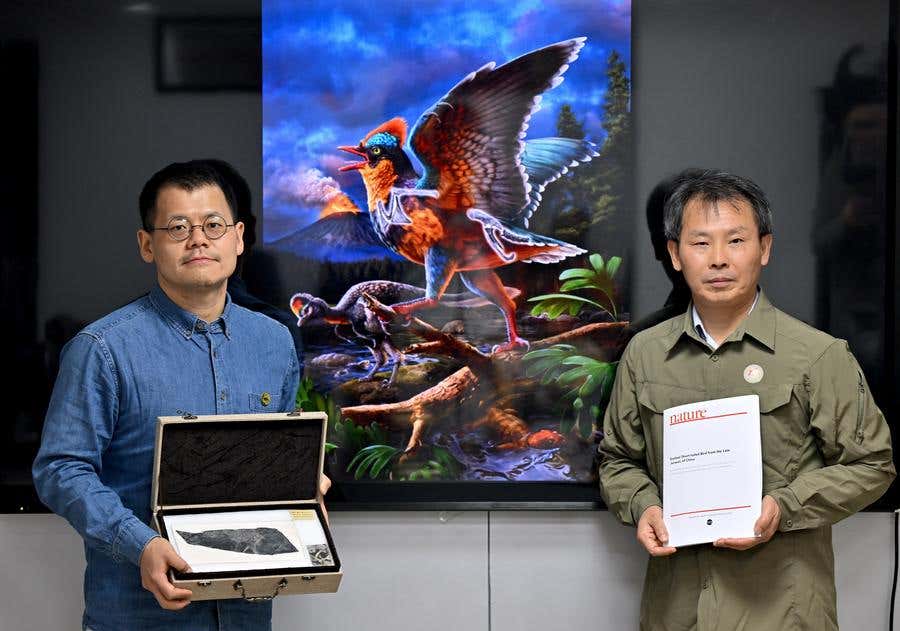Ancient fossil discovery in China rewrites the history of bird evolution
A new fossil discovery in China pushes back the evolution of short-tailed birds by 20 million years, reshaping early bird history.

Newly discovered fossils in China challenge the timeline of bird evolution, revealing that short-tailed birds existed 20 million years earlier than thought. (CREDIT: Jiang Kehong)
New fossil discoveries in China are changing what is known about bird evolution. Two bird fossils, dating back nearly 149 million years, were unearthed in Fujian Province. These fossils provide the strongest evidence yet that birds were already diverse by the end of the Jurassic period.
For years, scientists relied on a sparse fossil record to piece together bird evolution. The long-tailed Archaeopteryx was considered the only confirmed Jurassic bird. While it had feathered wings, its body closely resembled non-avian dinosaurs. Some recent studies even question whether it belonged to the avian lineage.
These new fossils challenge previous assumptions. One of them, named Baminornis zhenghensis, has a short tail ending in a pygostyle, the fused bone structure seen in modern birds. This pushes back the emergence of short-tailed birds by nearly 20 million years.
The Significance of Baminornis zhenghensis
The researchers, led by Professor Wang Min from the Institute of Vertebrate Paleontology and Paleoanthropology (IVPP), analyzed the fossils to determine their place in bird evolution. Baminornis zhenghensis showed a blend of features—bird-like shoulders and pelvis, but hands more similar to its theropod ancestors. This mosaic evolution pattern highlights the gradual transition from dinosaurs to birds.
“Previously, the oldest record of short-tailed birds was from the Early Cretaceous,” Wang explained. “Baminornis zhenghensis is the sole Jurassic and the oldest short-tailed bird yet discovered, pushing back the appearance of this feature by nearly 20 million years.”
The research team conducted phylogenetic analyses to establish where Baminornis zhenghensis fits in the avian evolutionary tree. The results placed it slightly more advanced than Archaeopteryx, reinforcing its status as a true Jurassic bird.
Related Stories
“If we take a step back and reconsider the phylogenetic uncertainty of Archaeopteryx, we do not doubt that Baminornis zhenghensis is the true Jurassic bird,” said Dr. Zhou Zhonghe, a co-author of the study.
A Second Fossil With Uncertain Placement
The second fossil, though incomplete, provides another clue in early bird evolution. It consists only of a furcula, the wishbone structure found in birds and some theropod dinosaurs. The team performed geometric morphometric and phylogenetic analyses to compare it with other fossils.
The results suggest this furcula belongs to Ornithuromorpha, a group of birds that thrived during the Cretaceous period. However, with only a single bone to study, the researchers refrained from naming a new species. More fossils are needed to confirm its classification.
Despite the incomplete evidence, this find suggests that diverse bird groups were already emerging by the Jurassic period. The Zhenghe Fauna, where these fossils were found, could hold even more undiscovered avian fossils.
Redefining the Jurassic Bird Record
These findings, published in Nature, support the idea that bird evolution was well underway by the Jurassic. Until now, the fossil record suggested birds did not become significantly diverse until the Cretaceous. This discovery challenges that timeline.
Birds are the most diverse vertebrates on land, but their early history remains poorly understood. Fossils like Baminornis zhenghensis help fill in the missing evolutionary links. With continued discoveries, the origins of modern birds may become even clearer.
The study was conducted by researchers from the Institute of Vertebrate Paleontology and Paleoanthropology (IVPP) under the Chinese Academy of Sciences (CAS) and the Fujian Institute of Geological Survey.
Note: Materials provided above by The Brighter Side of News. Content may be edited for style and length.
Like these kind of feel good stories? Get The Brighter Side of News' newsletter.
Rebecca Shavit
Science & Technology Journalist | Innovation Storyteller
Based in Los Angeles, Rebecca Shavit is a dedicated science and technology journalist who writes for The Brighter Side of News, an online publication committed to highlighting positive and transformative stories from around the world. With a passion for uncovering groundbreaking discoveries and innovations, she brings to light the scientific advancements shaping a better future. Her reporting spans a wide range of topics, from cutting-edge medical breakthroughs and artificial intelligence to green technology and space exploration. With a keen ability to translate complex concepts into engaging and accessible stories, she makes science and innovation relatable to a broad audience.



